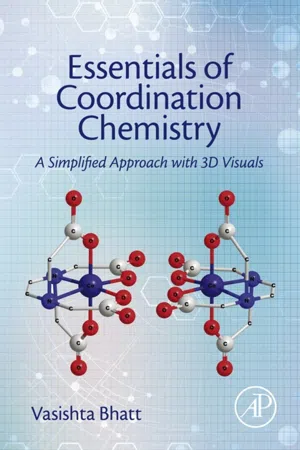
Essentials of Coordination Chemistry
A Simplified Approach with 3D Visuals
- 282 pages
- English
- ePUB (mobile friendly)
- Available on iOS & Android
About This Book
Essentials of Coordination Chemistry: A Simplified Approach with 3D Visuals provides an accessible overview of this key, foundational topic in inorganic chemistry. Thoroughly illustrated within the book and supplemented by online 3D images and videos in full color, this valuable resource covers basic fundamentals before exploring more advanced topics of interest.
The work begins with an introduction to the structure, properties, and syntheses of ligands with metal centers, before discussing the variety of isomerism exhibited by coordination compounds, such as structural, geometrical and optical isomerism. As thermodynamics and kinetics provide a gateway to synthesis and reactivity of coordination compounds, the book then describes the determination of stability constants and composition of complexes. Building upon those principles, the resource then explains a wide variety of nucleophilic substitution reactions exhibited by both octahedral and square planar complexes. Finally, the book discusses metal carbonyls and nitrosyls, special classes of compounds that can stabilize zero or even negative formal oxidation states of metal ions. Highlighting preparations, properties, and structures, the text explores the unique type of Metal-Ligand bonding which enable many interesting applications of these compounds.
Thoughtfully organized for academic use, Essentials of Coordination Chemistry: A Simplified Approach with 3D Visuals encourages interactive learning. Advanced undergraduate and graduate students, as well as researchers requiring a full overview and visual understanding of coordination chemistry, will find this book invaluable.
- Includes valuable visual content through 3D images and videos in full color, available online
- Provides a valuable introduction to the study of organic and inorganic ligands with metal centers
- Discusses advanced topics including metal carbonyls and nitrosyls
Frequently asked questions
Information
Basic Coordination Chemistry
Abstract
Keywords
Chelate; Complex; Grubb's catalyst; Ligand; Ligand field theory; Magnetism; Spectrochemical series; Suzuki reaction1. Introduction

Table of contents
- Cover image
- Title page
- Table of Contents
- Copyright
- Dedication
- Preface
- Acknowledgements
- Chapter 1. Basic Coordination Chemistry
- Chapter 2. Basic Concepts of Symmetry and Group Theory
- Chapter 3. Isomerism in Coordination Complexes
- Chapter 4. Thermodynamics and Kinetics of Complex Formation
- Chapter 5. Reactions in Octahedral Complexes
- Chapter 6. Reactions in Square Planar Complexes
- Chapter 7. Basic Organometallic Chemistry
- Chapter 8. Metal Carbonyls
- Chapter 9. Metal Nitrosyls
- Index